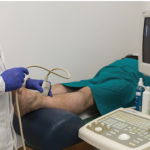Although both imaging technologies can help answer this question, neither is a substitute for a good clinical exam, Dr. Taylor said. But they can help assess the disease activity level (particularly for a subclinical disease presentation), confirm a previous diagnosis or, where the disease is established, investigate the presence of subclinical synovitis (the medical term for inflammation of the synovial membrane lining joints). Both imaging techniques delineate synovitis extremely well, although MRI can also delineate the surrounding anatomy, Dr. Taylor said. Both also predict subsequent structural damage, but ultrasound offers clinicians the advantage of easier accessibility.
Other examples of when imaging could prove therapeutically important include situations in which concomitant osteoarthritis might obfuscate diagnosis, when a patient’s weight makes results from the clinical exam equivocal or when the patient is supposed to be in disease remission but still suffers joint erosion. Imaging also allows quantification of the patient’s inflammatory burden by measuring the amount of synovitis. In general, a clinical assessment is a less sensitive means of detecting joint swelling.
This type of quantitative assessment of joint inflammation may also prove valuable in early phase clinical trials. Imaging can help the assessment of early inflammatory arthritis. For example, tenosynovitis has been shown to be an early feature of inflammation.
“In my practice,” said Dr. Taylor, “ultrasound can also enhance the doctor–patient consultation by providing an immediate visual assessment of the current state of disease activity.”
Dr. Taylor outlined various imaging modalities, including gray scale vs. high-frequency vs. Doppler power ultrasound, and STIR sequence, dynamic contrast-enhanced and gadolinium contrast MRI, and the importance of discussing the choices with a radiologist.
He referenced two recent studies trying to assess whether tight control of RA using ultrasound with treatment to target will lead to better outcomes for synovitis in early RA.3,4 Both studies resulted in increased use of therapeutic interventions from corticosteroids and biologics, but that didn’t seem to result in improvements in overall clinical outcomes, he said. As a result, the researchers concluded the systematic use of ultrasound with early RA patients treated aggressively with a treat-to-target strategy isn’t justified.
Infection Considerations
A third speaker, Kevin Winthrop, MD, MPH, professor of public health and associate professor of infectious diseases and ophthalmology at the School of Public Health and School of Medicine at Oregon Health & Science University in Portland, Ore., discussed the importance of managing and preventing the infections that can accompany RA and its array of immunosuppressive treatments. Prednisone is a strong risk factor for infection, so any approaches (such as biologics) that can limit prednisone may be important. The clinician must consider the patient’s age, whether they smoke, if they have chronic obstructive pulmonary disease or if they’re under other drug treatments that can add risk, Dr. Winthrop said.


